D-Day, Part III: “We are coming by day and by night”
Editor’s Note: This is part three of a three-part series exploring the history and significance of D-Day as we approach the 70th anniversary of the battle. Click here to read part one and here for part two. For information on D-Day: Normandy 1944, the 3D film now showing in the Wortham Giant Screen Theatre, please visit us online.
Less than a year separate these two images. On June 6, 1944, the Allies invaded France; on May 2, 1945, Soviet soldiers hoisted their banner on top of the Reichstag in Berlin. For the Allied armies advancing on Berlin, these intervening 11 months were anything but a cakewalk.
In France, German defenders stubbornly resisted the invasion. Hedgerow country in Normandy, known as theBocage, offered them shelter and hiding places. It was only after an enterprising individual had equipped the front of a tank with sharp steel spikes that it became possible to drive though the hedges and overwhelm German defenses.
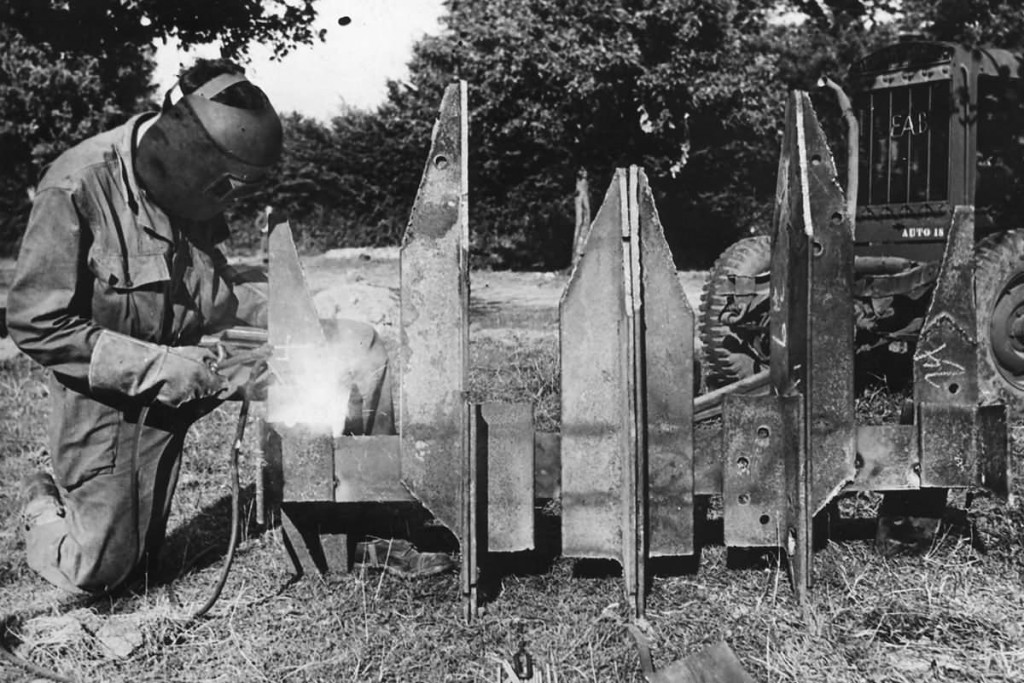 Under the command of General Patton, U.S. armored units broke through the German lines and raced toward Paris. The city was liberated on August 25, 1944. Antwerp, an important port city in Belgium, was liberated on September 4. Soon, much needed supplies were offloaded on its docksides. An attempt to rid the Netherlands of its German occupiers was only partially successful, as the Allies literally aimed for a “bridge too far.”
Under the command of General Patton, U.S. armored units broke through the German lines and raced toward Paris. The city was liberated on August 25, 1944. Antwerp, an important port city in Belgium, was liberated on September 4. Soon, much needed supplies were offloaded on its docksides. An attempt to rid the Netherlands of its German occupiers was only partially successful, as the Allies literally aimed for a “bridge too far.”
While armored units advanced over land to the German heartland, there was an equally ferocious battle being fought in the sky. British and American bomber forces leveled German cities and the factories in a determined effort to cripple Germany’s ability to wage war. This strategy, started in 1942 on a massive scale, continued up to a few days before the fall of Berlin. The quote at the top of this blog post comes from leaflets (and radio broadcasts) aimed at the German people. They warned:
“We are bombing Germany, city by city, and ever more terribly, in order to make it impossible for you to go on with the war. That is our object. We shall pursue it remorselessly. City by city; Lübeck, Rostock, Cologne, Emden, Bremen, Wilhelmshaven, Duisburg, Hamburg — and the list will grow longer and longer. Let the Nazis drag you down to disaster with them if you will. That is for you to decide. We are coming by day and by night. No part of the Reich is safe. People who work in [factories] live close to them. Therefore we hit your houses, and you.”
– Pamphlet dropped in Germany by the RAF, Summer 1942.
– Pamphlet dropped in Germany by the RAF, Summer 1942.
On the eastern front, Soviet troops continued their march westward. German resistance crumbled. The appearance of advanced technology, especially jet-powered airplanes, came too late and in insufficient numbers to make a difference. V-weapons, meant to exact revenge on Allies cities such as London and Antwerp, caused great loss of life. They did not, however, reverse the fortunes of war for Germany.
Christmas 1944 did not bring peace; a last gasp German offensive into the Ardennes region of southern Belgium resulted in the Battle of the Bulge. A German demand to surrender received a famous one-word answer from Brigadier General McAuliffe: “NUTS.”
By now German units were fighting on their own soil, in the east against Soviet forces nearing Berlin, and in the west against Allied forces occupying the industrial Ruhr area on their way east. Soviet and American forces eventually encountered each other at a crossing over the Elbe river. As they penetrated deeper into Germany, Allied soldiers liberated thousands of concentration camps. Evidence of the Holocaust became widely known abroad.
Soviet troops captured Berlin, sustaining and inflicting horrific losses. On April 30, 1945, Hitler committed suicide. Two days earlier, Benito Mussolini had been captured and killed in northern Italy. On May 7, 1945, Germany unconditionally surrendered and the war in Europe was officially over. All over Europe and the U.S. people celebrated Victory in Europe (VE) Day.
Hostilities were not yet over. In the Pacific theater, the war against Japan continued. Two atomic bombs dropped on Japan brought the bloody conflict to an end some three months after peace came to Europe.
As far as Europe is concerned, one can confidently say that the D-Day invasion marked the beginning of the end for the Third Reich. Forced to fight on two fronts, Germany ran out of men and material.
The Houston Museum of Natural Science’s Wortham Giant Screen Theatre is now showing D-Day: Normandy 1944. The film is running exclusively at HMNS in the Houston-Galveston area through November 11.
In honor of the 70th anniversary of D-Day, on Friday, June 6 we’ve added additional screenings of D-Day: Normandy 1944 (at 5:00 p.m, 6:00 p.m. and 7:00 p.m.) in the Wortham Giant Screen Theatre.
Thanks to a generous donation from Gallery Furniture, all military personnel (active duty and veterans) can see D-Day: Normandy 1944 for free.
We’re also starting our Take Two series this month in the Wortham Giant Screen Theatre beginning Friday, June 6 with a showing of Saving Private Ryan (8:30 p.m.) and on Friday, June 13 with The Longest Day (7:00 p.m.).
Local support is provided by Gallery Furniture and IBERIABANK.
D-Day, Part II: “We will accept nothing less than full victory”
Editor’s Note: This is part two of a three-part series exploring the history and significance of D-Day as we approach the 70th anniversary of the battle. Click here to read part one. For information on D-Day: Normandy 1944, the 3D film now showing in the Wortham Giant Screen Theatre, please visit us online.
“I have full confidence in your courage, devotion to duty and skill in battle. We will accept nothing less than full victory!” – General Dwight D. Eisenhower, June 6, 1944.
With these words, General Dwight D. Eisenhower ended his message to the troops as they headed for the beaches of Normandy on D-Day, June 6th, 1944.
Once the decision had been made at the Trident Conference to open a second front and invade Western Europe, preparations needed to be made to ensure the mission’s success. This involved deciding when and where to land, devising measures to deceive the Germans, and working out all the logistics to make these plans work.
As to the “where,” the German High Command assumed that the Pas de Calais in Northern France was the likeliest place for an Allied invasion. This was not unreasonable. At 21 miles, it marks the shortest distance between German-held territory and Allied-held territory. To put things in perspective, this distance of 21 miles is slightly less than the length of the causeway across Lake Pontchartrain, north of New Orleans.
The Germans looked at this spot as a jumping off point for their own invasion of England. One photo shows German officers, including Herman Goering, standing on the beach at Pas de Calais, looking at the white cliffs of Dover. That was as close as they would ever get.

Lake Pontchartrain, Louisiana. The city of New Orleans is visible to the south of the lake. The causeway is the straight line crossing the lake, covering a distance equal to that between Calais, northern France and Dover, England. (Image: Wikimedia)
The Allies selected Normandy for various reasons. It had good beaches, which were protected from western gales by the Cotentin Peninsula, or Cherbourg Peninsula. While it was further away from England than Pas de Calais, Normandy was also not the place where the Germans expected the landings to happen. The beaches in Normandy remained within easy reach of fighter airplanes, guaranteeing that there would be sufficient air cover to protect the troops when they hit the beach. By 1944, the German air force was no longer as powerful as it once had been.
As to when to invade Normandy, the Allies relied on tides, available moonlight, and good weather. Coming in with full knowledge of the tides would allow the boatmen of the landing craft to get close enough to the beach, while still being able to avoid the extensive belt of beach obstacles. In 1944, it was determined that optimum conditions would exist toward the end of May.
Once a “where” and “when” were decided upon, it became necessary to deceive the Germans. An operation this size could not remain hidden. The Allies decided that the best course of action was to make the Germans look the wrong way. The Allied deception plan – known as “Operation Bodyguard” — employed various schemes to mislead the Germans.
Fake infrastructure and equipment (including inflatable replicas of tanks and vehicles) was used to simulate non-existing army units. Radio traffic was generated to reinforce that impression, with messages exchanged among these make-believe units. Well known military figures, most famously General Patton, were also part of the deception plan. General Patton took on a high visibility profile in Southeast England, the area where the non-existing First United States Army Group was supposed to have set up camp. Ghost armies would continue to play a role during the remainder of the war.
The Allies also made use of diplomatic channels, double agents and other very creative ruses to leak tidbits of information to deceive the Germans into believing the main invasion would happen anywhere but Normandy, and that any action there would be part of a diversion and nothing more. Eventually, after an agonizing delay because of bad weather, the invasion was launched. D-Day was underway.
Wave after wave of airborne units had gone in ahead of the main body. Their job was to secure bridges, and secure the flanks of the invasion area. The invasion area was 50 miles wide; a mind-boggling distance roughly equal to what separates Houston from Galveston, or Washington, D.C. from Baltimore.
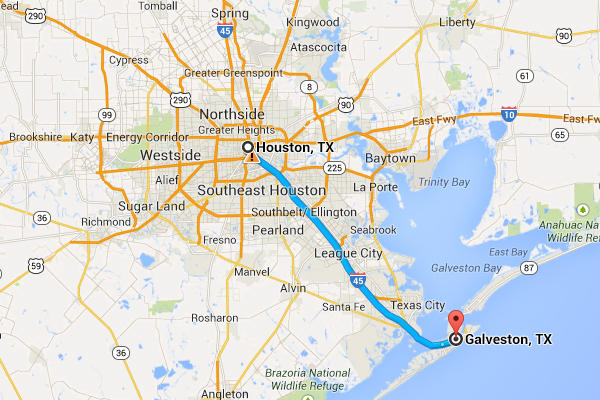 American, British, Canadian and other Allied forces came ashore that day facing a well-entrenched enemy. For more than a year, Marshal Rommel had been in charge of fortifying the mainland against an invasion they knew would come one day. A huge workforce had been employed to build strong points from Norway to the border with Spain — a distance of about 1,500 miles. A giant German version of the French Maginot line, these fortifications were named the Atlantikwall.
American, British, Canadian and other Allied forces came ashore that day facing a well-entrenched enemy. For more than a year, Marshal Rommel had been in charge of fortifying the mainland against an invasion they knew would come one day. A huge workforce had been employed to build strong points from Norway to the border with Spain — a distance of about 1,500 miles. A giant German version of the French Maginot line, these fortifications were named the Atlantikwall.
Fortified coastline of German-occupied Europe, known as the Atlantikwall, shown in green (Image: Wikimedia)
From 1943 to 1944, bunkers, observation points and gun emplacements were constructed at a feverish pace. Among these fortifications was a series of bunkers and gun emplacements at a location called Pointe du Hoc, a rocky promontory overlooking Omaha Beach. Allied intelligence surmised that these strong points sheltered huge 155 mm artillery pieces which, it was feared, could wreak havoc on the landing beaches. These guns had to be neutralized, and the U.S. Army Rangers were selected to do the job.

Pointe du Hoc bunker, remains of charred ceiling beams, evidence of the intense fighting that took place here (Photo: Dirk Van Tuerenhout).
Intense fighting ensued. Bunkers were attacked with all available weapons, including flamethrowers as well as naval artillery. Much to their surprise, the Rangers established that the artillery, thought to have been in the emplacements, had been moved inland. They were able to locate and destroy them, as well as a huge ammunition dump nearby. In doing so, they saved a lot of lives.
The commanding officer of the Rangers was Colonel James Earl Rudder. He was wounded during the attack, but survived and eventually became the sixteenth President of Texas A&M University. Among the huge armada of ships firing at the German fortifications was the USS Texas. She sailed up and down the coast, firing at Pointe du Hoc as well as the coastal guns defending the port of Cherbourg. Some of the Rangers wounded during the Pointe du Hoc operation were treated on the USS Texas.
By the end of the day, Allied forces had become sufficiently entrenched on the Normandy coast. It would take another year before the “1000-year Reich” came crashing down. That part of the story will be covered in the third and final blog on this topic.
The Houston Museum of Natural Science’s Wortham Giant Screen Theatre is now showing D-Day: Normandy 1944. The film is running exclusively at HMNS in the Houston-Galveston area through November 11.
Click here to read the next in this series, D-Day, Part III: “We are coming by day and by night”
Local support is provided by Gallery Furniture and IBERIABANK.
What the Heck is a Tues, Wed, Thurs, or Fri?
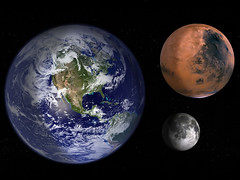 |
We measure time based on motions in space. The Earth rotates on its axis once a day. The Moon orbits the Earth about once a month. The Earth orbits the Sun once a year. That leaves the week as the only aspect of our calendar not directly tied to the Earth, Moon, or Sun. The week, as it turns out, is based on the other planets of our solar system–at least, those easily visible to the naked eye.
Early astronomers were able to distinguish planets from stars because planets seem to move against the starry background. The stars are always rising, moving across the sky, and setting due to Earth’s rotation. They seem to form the same patterns all the time; we never see them move relative to each other. (In fact the stars do have proper motion, but we don’t notice it over a time frame as short as a human life or even over several generations). Anything shifting noticeably over several days was a ‘wandering star’, or planet. Early astronomers identified seven ‘wanderers': the Moon, Mercury, Venus, the Sun, Mars, Jupiter, and Saturn, and the Greeks placed them in just that order.
This order, of course, is wrong; it makes the basic error of putting the Sun in orbit around the Earth when in fact the Earth orbits the Sun. Fixing this error by replacing the Sun with the Earth, however, makes the order from Mercury to Saturn correct. That’s because the order is based on something directly observable–the planets seem to move among the background stars at different rates. Ancient observers saw the Moon reappear near the same set of stars once a month. Saturn, on the other hand, takes 29.5 years to reappear in the same part of the sky.
The different speeds are even more apparent when two or more planets are near one another in the sky (an alignment called conjunction). Any planet in conjunction with Saturn catches up to Saturn and then passes it. It’s never the other way around. Any planet (other than Saturn) in conjunction with Jupiter catches and passes Jupiter, never the other way around. For early astronomers, slowness was associated with distance. By carefully observing the planets’ motions and planetary conjunctions, early observers could place them in order.
Ancient Roman writer Dio Cassius was among the first to explain how the order of the planets from slowest to fastest (and thus from outside in) generated the week. The system involves the 24-hour day and an astrological belief that each hour was ‘ruled’ by a planet following the order above, such that Saturn’s hour was followed by Jupiter’s, then Mars’, then the Sun’s, and so on. Further, whichever planet governed the first hour of each day governed that whole day. On Saturn’s day, then, the hours were as follows:
1) Saturn 2) Jupiter 3) Mars 4) Sun 5) Venus 6) Mercury 7) Moon 8. Saturn 9) Jupiter 10) Mars 11) Sun 12) Venus 13) Mercury 14) Moon 15) Saturn 16) Jupiter 17) Mars 18) Sun 19) Venus 20) Mercury 21) Moon 22) Saturn 23) Jupiter 24) Mars 25) Sun
Since there are 24 hours in a day, the 25th hour of Saturn’s day is the first hour of the next day. Therefore, Saturn-day is followed by Sun-day. Redo the list of hours, this time starting with the Sun, such that hours 1, 8, 15, and 22 are the Sun’s. Hour 25 becomes the Moon’s hour, which means the Sun-day is followed by Moon-day. Repeat the list with the Moon in first position, and eventually the following order of days emerges:
1) Saturn-day 2) Sun-day 3) Moon-day 4) Mars-day 5) Mercury-day 6) Jupiter day 7) Venus-day
If Venus governs the first hour, Saturn governs the 25th, and the cycle begins again. A full table of the hours and days is here (this list also has the name of the days in 30 different languages).
You probably recognize Saturday, Sunday, and Monday in this list. To get the other English day names from this list, we have to translate by replacing the planet names, which are names of Roman deities, with roughly equivalent Germanic deities. Languages derived directly from Latin have preserved the Roman gods’ (thus the planets’) names more faithfully. For example, you can recognize Latin luna (the Moon) in French lundi, Spanishlunes, and Italian lunedì.
 |
Similarly, Mars-day is martes in Spanish, mardi in french, and martedì in Italian. Germanic tribes, however, replaced the Roman war god Mars with their own warlike god Tiw (or Tyr for the Norse). Thus, Mars’ day became Tiw’s day or Tuesday.
‘Mercury-day’ is recognizable in French mercredi, Spanish miércoles, and Italian mercoledì. The Germanic pantheon had no messenger god that corresponded well to the Roman Mercury, so they equated him with Woden (Norse Odin). Both Woden and Mercury were gods who escorted the recently deceased to the underworld. Also, Woden became the fastest god when he rode his eight-legged horse Sleipnir.
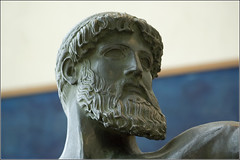 |
Jupiter’s original name in Latin was Jovis (‘Jove’ to English writers); the name Jupiter is a contraction of Jovispater (‘father Jove’). ‘Jove-day’ is recognizable in French jeudi, Spanish jueves, and Italian giovedì. Although Jupiter, like the Greek Zeus, was the king of all the gods, his actual domain was the weather. In particular, he was the god who caused storms and struck people with lightning. Thus Germanic tribes assigned his day toThor, their god of thunder. Thor’s day is Thursday.
‘Venus-day’ is still recognizeable in French vendredi, Spanish viernes, and Italian venerdì. Germanic tribes replaced Venus’s name with that of Frigg, the wife of Woden who was associated with married women and whom they called upon to help in giving birth. Frigg-day is Friday.
As the Germanic tribes had no one in their pantheon who even roughly corresponded to Saturn, Saturn’s name remains in Saturday. Ironically, the Latin-based languages have lost ‘Saturn-day’ as the day’s name. Spanishsábado and Italian sabato derive from the word ‘sabbath’ (as does French samedi, through a more complex etymology). This is due to the influence of the Catholic Church, which was loath to name the days of the week after pagan gods, and sought to replace the planetary names.
The Church designated Sunday ‘Lord’s Day’ (dies dominicus), called Saturday the sabbath (sabbatum), and numbered the weekdays from 2 to 6. Except in Portugal, however, the numbered weekdays never replaced the planetary days in popular usage. Everyday people in southern Europe did adopt the Church’s terms for the weekend days. Northern Europe, largely outside the influence of the Catholic Church, was less affected by this; we retain ‘Saturday’ and ‘Sunday’ in English as a result.
In November and December 2008, you can make for yourself some of the observations that helped astronomers of antiquity imagine the solar system. The two brightest points of light in the southwest tonight are Venus and Jupiter. They outshine all stars we ever see at night and are visible even in twilight. But don’t wait too late; you’ll need to look in the hours right after sundown before the two planets set. Venus, lower to the horizon, is the brighter of the two. Its closeness to us and the clouds that cover the whole surface and reflect most sunlight back into space cause Venus to outshine the much larger Jupiter.
Watch as Venus gets closer and closer to Jupiter each night this month. This is exactly how ancient astronomers could tell that Venus and Jupiter were not stars. On November 30 and December 1, watch as Venus passes 2 degrees ‘under’ Jupiter. (The crescent Moon also passes by on these nights). Imagine ancient Greek astronomers concluding that Venus is closer because it is faster. Keep watching each night in December as Venus pulls away from Jupiter, getting higher in the dusk sky while Jupiter sinks into the Sun’s glare by early January. Early astronomers would have seen this as the Sun catching up to Jupiter while Venus pulls away; observations like this account for the Sun’s position in the ancient order of ‘planets’. Of course, we now know better–the Sun’s apparent motion is really ours. Earth is going around the far side of the Sun from Jupiter’s position, putting Jupiter behind the Sun as the New Year opens.
Venus remains an evening star until March 2009. Compare Venus to the stars around it, and you’ll see it slow down and then move ‘backwards’ towards the Sun’s position each night in March. That’s because Venus will have come around to our side of the Sun, and will be passing us up on its faster orbit.
Should you make any of these observations on a Thursday or Friday, you can reflect on why those days have those names.
Happy New Year!
The New Moon of Monday, September 29, is an important one to many people of the world. In the Hebrew Calendar, it marks Rosh Hashanah (literally, ‘head of the year’) which is the beginning of year 5769. On Tuesday night, September 30, Muslims across the world will see the first slender crescent of this lunar cycle. That will mark the end of Ramadan and the beginning of the next month, Shawwal. 1 Shawwal is ‘Eid ul Fitr, one of the greatest holidays in the Islamic calendar. This week, then, is a good time to think about the Moon, why it’s here, how it orbits, and how we have used it to measure time.
 |
Unlike our months, Hebrew and Islamic months begin with the New Moon. Because twelve lunar months add to only 354 days, less than the 365.25 day solar year, an extra month is occasionally needed to keep the months roughly aligned with the seasons. In a 19 year cycle, years 3, 6, 8, 11, 14, 17, and 19 have the extra month. The year that is ending, 5678, is number 11 in its cycle and was a leap year.
Interestingly, the Jewish year has two ‘beginnings’. Tishrei (the month which begins now) is the first month of the civil calendar, and the month where 5678 becomes 5679. However, it is actually the seventh month of the religious calendar, which begins at Nisan (the month of Passover).
The Islamic calendar functions slightly differently. Its months begin with the first visible crescent low in the west at dusk, which is not with the actual New Moon. Keep in mind that at New Moon, the Moon is in line with the Earth and Sun, and the entire near side of the Moon has nighttime (and is therefore dark). The New Moon is visible, therefore, only if it blocks the Sun during an eclipse.
Since this New Moon occurs early Monday morning, the 29th, we expect it to be visible by Tuesday evening, the 30th. Observant Muslims, then, will continue to fast in daylight hours Monday and Tuesday. Upon seeing the Moon Tuesday night, they will know that Ramadan has become Shawwal, and they may break their fast on Wednesday.
Due to early controversy as to which years would have it, Muhammad outlawed the 13th month that kept Islamic months tied to the seasons. As a result, Ramadan (and each other month in that calendar) begins 11 days earlier each year according to our Gregorian calendar.
The Moon is Earth’s only natural satellite, orbiting our planet once every 27.3 days. However, a cycle of moon phases (say, from New Moon to the next New Moon), takes 29.54 days. This is because the Earth itself is moving during each 27.3 day Moon orbit. Since it is much easier to observe the Moon’s changing phase cycle than to observe the Sun directly, the 29.54 day phase cycle was the basis of many ancient calendars. Words for ‘moon’ and ‘month’ are related in English and are identical in many other languages. There is some evidence that our word ‘moon’ is ultimately related to an Indo-European word for ‘measure.’ Given how long we’ve measured time by the Moon, it is easy to take its presence for granted.
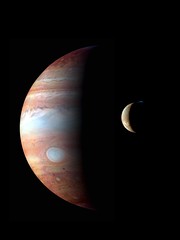 |
However, our Moon is quite remarkable in several ways. Moons in our solar system are generally much smaller than the planet they orbit. Jupiter and Saturn, for example, are about 25 times bigger across than their biggest moons. Earth, though, is only 3.67 times the diameter of our Moon. Also, moons usually orbit in the same plane as their planet’s equator. Our Moon, though, orbits within about 5 degrees of Earth’s orbital plane, called the ecliptic, which is not the plane of the equator since Earth is tilted 23.5 degrees on its axis.
This leads most astronomers to believe that the Moon did not form with the Earth, but is the result of a collision with with an object roughly the size of Mars. According to this theory, the impactor (sometimes called ‘Theia’) struck a glancing blow on the Earth and was completely destroyed, and the Moon formed from the debris of Theia’s and Earth’s mantles.
This impact is what left Earth with a Moon much larger than what a planet Earth’s size would normally have, and left that Moon near Earth’s orbital plane (where the impact occured). Our relatively big moon has crucial effects not only on our tides, but also on the stability of Earth’s tilt.
Earth’s orbital tilt of about 23 and a half degrees as it goes around the Sun causes the seasons. The axis precesses, describing an aparent circle roughly every 26,000 years, but the amount of tilt (obliquity) stays nearly the same. Because the Moon acts a counterweight, the obliquity varies only between 22.1 degrees and 24.5 degrees over about 41,00 years (we are now at 23.44 degrees and decreasing). Even this orderly variation, called the Milankovitch cycle, is enough to influence our Ice Ages. Imagine the impact on Earth’s climate if there were no Moon, and the obliquity varied chaotically. This is exactly what happens at Mars, where the tiny moons Phobos and Deimos are not massive enough to influence Mars’ tilt.
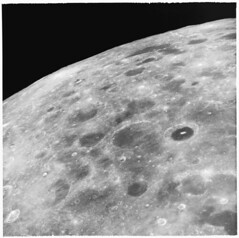 |
One thing our Moon does have in common with most others is that it orbits the Earth and rotates on its own axis at the same rate. This is called ‘synchronous rotation’ and it occurs because the Moon is not exactly uniform in composition. From the time the Moon formed, the slightly heavier side was attracted to the Earth. Over time, this effect de-spun the Moon until it attained synchronous rotation. The Moon’s gravitational attraction also de-spins the Earth, although much more slowly as the Moon is less massive. As it does so, the Moon moves slightly farther from the Earth (just over 3 cm per year). The Moon is now 1.5 meters farther away that it was when Apollo astronauts went there. Don’t worry, though, by the time the Moon is far enough away to escape, the Sun will have become a red giant and swallowed both Earth and Moon anyway.
What is the shape of the Moon’s trajectory around the Sun? Perhaps not what you’d expect.
So, I encourage every one to watch for the reappearance of the Moon in the evening sky this week, even if you aren’t celebrating a New Year or an ‘Eid. The Earth’s companion gives all of us something to appreciate.








